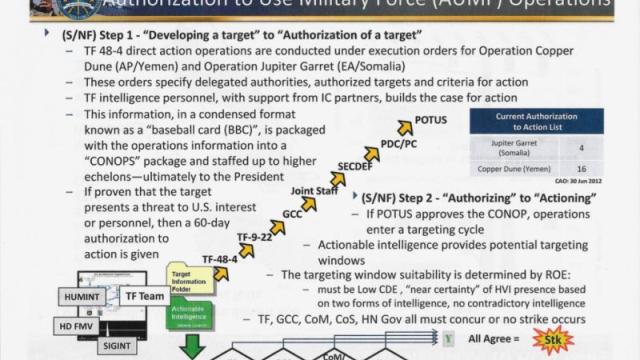Does this Powerpoint slide damage America’s national security?
Published in a report from The Intercept about America’s drone programs, the slide shows the chain of command used to authorise attacks during Joint Special Operations Command operations in Yemen and Somalia, right up to the President of the United States.
It shows whoever looks at it classified information about the military. But why classify the chain of command for a modern form of warfare? The chain of command is a bureaucratic arrangement, not a security threat. Overzealous, errant secret-keeping is the problem here.
The CIA and JSOC don’t have to tally their strikes, or the number of people they kill. There is no independent judicial oversight. Despite consistently congratulating itself on coming up with a more precise way to hunt enemies, the government obfuscates its assassination campaigns so the public has had no clear view of the alleged precision.
The slide, taken from a 2013 Pentagon Intelligence, Surveillance, and Reconnaissance Task Force study, is classified as Secret/NoForn. “NoForn” is “no foreign nationals,” which means the US didn’t share this chain of command with allies such as Australia. A “Secret” designation is the second-highest government document classification, theoretically reserved for information “that the unauthorised disclosure of which reasonably could be expected to cause serious damage to the national security.”
Explaining that the US president gets his “baseball card” of information about the opportunity to kill an enemy from the Principals’ Deputies Committee/Principals Committee, which gets it from the Secretary of Defence, which gets it from the Joint Staff, which gets it from the Geographic Combatant Command, and so on — that’s hardly doing a terrorist any favours. If anything, it’s irritating the terrorist by being aggressively boring.
“To an outside observer, it is hard to see why this slide would be classified. It seems far-fetched to claim that any of these procedural details would literally ‘damage national security,’” Steven Aftergood, director of the Federation of American Scientists’ Project of Government Secrecy, told me.
Aftergood’s not really an outside observer. His lawsuit against the CIA helped declassify the intelligence budget back in 1997. He’s a staunch advocate for government transparency — and he played a good devil’s advocate telling me why the government could argue for classification:
First, it concerns classified military operations, i.e. Copper Dune and Jupiter Garret. Almost everything about those operations other than their code-names is classified. As a practical matter, the government doesn’t start by asking what parts of a classified activity should be classified. Rather, it assumes everything about them is classified, and asks what if anything can be disclosed.
While it may not be practical, having a default position of withholding all information from the public that contains a reference to a classified activity is a terrific way to get out of informing the public of all kinds of shit. In this slide, we learn very little about Copper Dune and Jupiter Garret. Except:
Second, the slide actually goes beyond mere procedural, chain-of-command information and identifies the number of operations that have progressed from “authorization” to “action.” This gives an idea of the operations’ scale and status, which could be sensitive information in some contexts.
That’s the most convincing argument for classification, but it’s still a weak one. While specifying that Jupiter Garret and Copper Dune had 4 and 16 drone kills in the hopper does show the general scope of the programs at the time, it does little more than confirm that the programs were operational. Having basic details about drone strikes is in the public interest. In conventional warfare, the existence of battles is not classified. Broad-strokes confirmation that the US government is attacking its enemies should not be classified, nor should the reasons that these human targets are considered our enemies.
This slide does not threaten America’s national security. What its publication does threaten is the secrecy apparatus shielding the drone program from the scrutiny any government program focused on killing people as quietly as possible deserves.
In December 2012, the Public Interest Declassification Board — an advisory board set up by Congress — warned the president that over-classification was turning into a crisis. “At its most benign, secrecy impedes informed government decisions and an informed public; at worst, it enables corruption and malfeasance,” the PIDB wrote, advocating for greater openness. Clearly, nobody at JSOC was listening.
The chain of command isn’t the most immediately arresting thing in The Intercept’s report. One slide shows 9 out of 10 people killed in an attack on northern Afghanistan were bystanders — evidence that calling drone strikes “surgical” only works if you’re used to doctors operating with chainsaws. Meanwhile, the bureaucratic slides outline process. Yet slides like the “kill chain” are evidence that the American government is pursuing a warfare program with the smallest amount of oversight possible.
Screenshot via The Intercept
